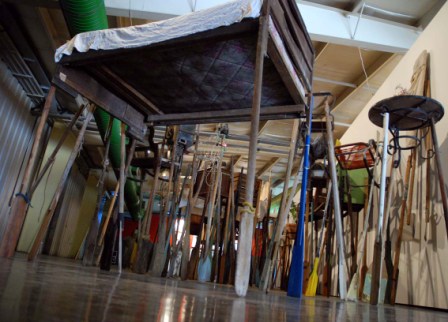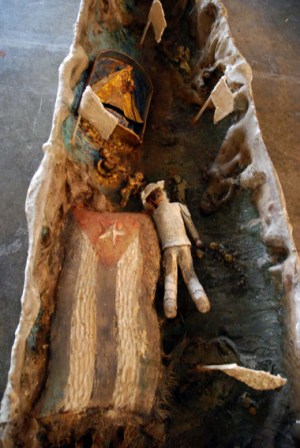Art: Reflection of Reality
By IRINA ECHARRY, photos: CARIDAD

HAVANA TIMES, April 15 – Can art change the thinking of human beings? That is a question that not everyone answers the same way. You would have to take into account the circumstances in which the work is produced and to whom it’s directed.
Within the Cuban public there are those who look to the visual arts for new interpretations of daily life. It’s that public that took the trouble to go out to Pabexpo facility, located far from the city center. They went to see the exhibition displaying the work of Cuban visual artists who have participated in other editions of the Havana Biennial.
After a memorable trip (given the distance and the number of buses we had to catch on this journey), we went into in a room where what prevailed was reflection, questions and criticism.
The sea, with all its depth and enigma, is a constant of our artists, perhaps because we live on an island, or maybe because it’s a symbol of freedom and, at the same time, of confinement. Possibly it’s because of the importance that the sea has had from the time of Christopher Columbus’s encounter with our land until today; those waters that move away and come closer at the same time. Or it could be due to the shades of its colors, although this time there were not paintings being featured, but sculptural installations.

Agustín Bejarano’s The three boats (a simile of Columbus’s three ships) contained the history of the island in the form of vignettes. They appeared as images ranging from the Caridad del Cobre (the patron virgin of Cuba) to Elpidio Valdés, the hero of children’s cartoons who represents the Cuban mambises that fought the Spanish colonizers.
Offered are images of those patriots who fought for the independence of Cuba, pioneers, the later “rebels” of the Sierra Maestra and flags of different colors. But what awakens most curiosity is a man rushing from a wall (which could be the Havana seawall) trying to get into one of the boats. Is this an image of a vicious circle or a metaphor for the thousands of balseros [Cuba’s boatpeople of the 1990’s] who rushed to the sea looking for a different life?
Oars that held up the various rooms of a house full of furniture and old accessories were the work of Kcho, who despite repeating the theme, contributed a more solid vision of his art in this work. There were no people, yet the house seemed inhabited. Could it be that we are like ghosts? – ghosts who live in an (insecure) antiques warehouse?
Again the island appeared, this time in the work of René Francisco, who represented it as a great blot of people closely united. From a different perspective, the nation’s geography took the form of a caiman with airplane wings, with its mouth wide open as if it wanted to swallow everything it found in its path; this was Esterio Segura’s version.

Feminine faces of different ages illuminated by a candle were presented to us by Aimée García, while Analía Anaya showed us a park sui generis: a bench with fluorescent lamps and a black garden with glass flowers in which we could see our reflections, albeit somewhat distorted. And there was Pedro Pablo Oliva, continuing with the theme of insecurity by putting his characters on a tightrope.
However, Abel Barroso, on a more optimistic note, offered us a bridge that reached to different cities of the world.
The expo-sale, which lasted until April 12, was representative of today’s art. This inquiry into themes that affect Cuban society showed men and women facing their existential problems, illusions, needs and frustrations.
That is what art is for, to create uncertainty, to ask or to respond.
It’s only a shame that it was in a place so far away as Pabexpo, and that not everyone could go to see how our artists represent the relationship of people with their contexts.
The 10th Havana Biennial continues through April 30th at numerous venues in the Cuban capital.
Click on the thumbnails to see all the photos in this gallery





























